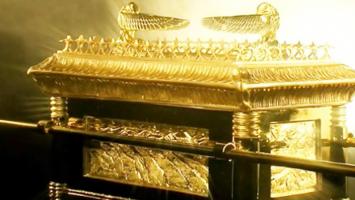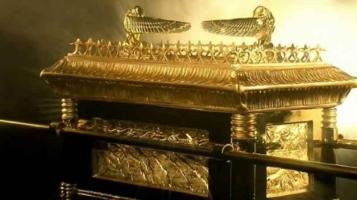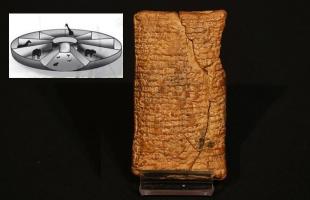The Ark of the Covenant


Moses' terrifying weapon. A propitiatory to speak with God. The ark hidden in Ethiopia. Three Italians find it in Axum. It will reappear on Judgment Day.
The scene takes place on a sacred mountain of ancient Egypt, in the Sinai Peninsula, along a path whose passage is forbidden to common people. Kneeling before a burning bush, the prophet Moses is listening to the orders of the God of Israel. "Make an ark of acacia wood and overlay it with pure gold. And inside you shall place the Testimony that I will give you," commands the Lord Yahweh.
And Moses obeys. Assisted by his faithful Bezaleel, and following precisely the instructions of his God, the Hebrew patriarch constructs a chest 125 centimeters long, 75 high, and 75 wide and overlays it with pure gold, both inside and out. He then covers it with a golden lid, called the mercy seat. Above it, he places two small statues, representing cherubim. On the sides of the chest, he fits four rings so that it can be carried more easily, without touching it, by inserting two poles.
Inside the Ark of the Testimony, the most sacred object of the Hebrew religious tradition, the prophet places some of the manna collected during the crossing of the desert, the magical rod with which the plagues were unleashed against Egypt and the waters of the Red Sea parted, but especially the Tablets of the Ten Commandments, the tangible sign of the covenant with God.
A TERRIBLE WEAPON OF WAR
Continuing in the biblical book of Exodus, we then discover that from that moment, Moses imposes on his people a series of so precise and inscrutable as incomprehensible provisions for the custody of the sacred object. The sons of Aaron and the Levites will handle the ark, and they cannot approach it until it has been covered by the priests; during the exodus, the chest will be placed inside the Tent of the Lord (a kind of collapsible temple) during stops and carried at the head of the people during marches; no one must ever touch it. And especially, at particular moments, only Moses will use it to make God appear enthroned in the space between the two cherubim.
Moses' instructions were followed to the letter until the disappearance of the ark, which probably occurred in 587 BC. That year, the Babylonian armies defeated the Jews and plundered them of every possession. Before that date, once the Promised Land was reached, the Levites placed the ark in the sanctum sanctorum, a highly secret underground chamber twenty cubits by twenty in the Temple of Jerusalem.
No one was allowed to enter, and the ark itself was only shown in public on exceptional occasions.
And the reason for such secrecy was linked to the dangerous and uncontrollable power attributed to this object.
It was said that the ark, at particular moments, would be surrounded by light and could unleash divine power, annihilating thousands of people. How this happened is not clear. But it is certain, if we believe the ancient biblical chronicles, that with the ark at their head, the Jews were able to annihilate the dozens of hostile tribes they encountered during the exodus in the Sinai Desert. The biblical account presents a real war bulletin: the ark's lightning would have destroyed the armies of the Hittites and Gergesites, the Jebusites and Amorites, and about a dozen other populations that lived in the Canaan strip in the 13th century BC.
What these divine lightnings were is not clear. In some passages, the Bible implies the presence of an unidentified exterminating angel, while various verses in Exodus and the Second Book of Samuel clearly state that anyone who touched the ark died struck by God. As happened to Aaron's sons, although they were the expert keepers of the relic, and to a certain Uzzah who, wanting to prevent the ark from overturning during transport, grabbed it with his hands and died instantly, to general dismay.
But the greatest victory of the ark remains the destruction of the city of Jericho. Regarding this episode, the Book of Joshua is very clear. By God's command, for six days the armies of Israel, led by seven priests carrying seven ram's horn trumpets and the ark of the covenant, circled the cyclopean bastions. "And on the seventh day, when the trumpets sounded, the walls fell," the Bible says.
A LEYDEN JAR?
Assuming the truth of these episodes, what kind of explanation can we give, beyond the easy assumption of God's intervention?
According to French writer Robert Charroux, "the ark was nothing more than an impressive weapon capable of developing electrical energy. We must not forget that Moses, when still trained as a future pharaoh, had received from the Egyptian priests deep alchemical-esoteric notions of chemistry, physics, and meteorology such that he could account for some of the prodigies attributed to him. The Ark of the Covenant could have been a kind of electrical chest capable of producing strong discharges of the order of 5-700 volts..."
"The ark was made of acacia wood - writes the researcher - and lined with gold inside and out. On this same principle, electrical capacitors are constructed, separated by an insulator which in that case was wood. The ark was placed in a dry area, where the natural magnetic field normally reaches 600 volts per vertical meter, and it charged up. Its very garland perhaps served to charge the capacitor. To move it, the Levites passed two gilded poles through the rings, so that from the garland to the ground the conduction occurred through natural ground, discharging safely. Isolated, the ark sometimes glowed with rays of fire, flashes, and, if touched, gave terrible shocks. In practice, it behaved exactly like a Leyden jar..."
SEEKING GOD'S RADIO
According to Charroux, then, the ark was nothing but an electrical weapon built on the basis of ancient knowledge lost and kept only by the Egyptian Initiates. Also thanks to this knowledge, which for Swiss popularizer Erich Von Daeniken was instead of extraterrestrial origin, Moses would have built a propitiatory that functioned like a transistor radio. Only in this way, the writer explains, could Moses speak as to a friend with the Lord God.
These incredible performances could then explain the manifest interest of other populations towards the holy ark.
The Temple of Jerusalem, where the sacred relic was kept, was repeatedly plundered: in 925 BC by the Egyptians of Pharaoh Shoshenq I, in 797 by Joash king of Israel, in 621 by Chaldean and Babylonian armies.
When the object disappeared is not certain. Certainly, when in 516 BC the prefect Zerubbabel rebuilt the Temple of Jerusalem, the ark was no longer there.
Or at least, not visibly, according to Israeli Rabbi Shlomo Goren, convinced that the ark is currently still in the sanctum sanctorum, escaped from the raids of the invaders.
"It would be enough to dig in correspondence with its ancient location. - declares Goren - Unfortunately, however, now in that area stands the Islamic mosque esplanade of Jerusalem and the religious authorities prefer to avoid any archaeological excavation to avoid friction with the Muslims..."
AMONG THE FALASHA OF KING SOLOMON
According to another version, recounted in the 14th-century Ethiopian chronicle Kebra Nagast or Glory of Kings, the Ark of the Covenant would be in Axum, Ethiopia. It was allegedly brought there by a certain Menelik, who tradition holds was born from the marriage of King Solomon with Makeda, the queen of Sheba. The son of the young and attractive Ethiopian, in agreement with a handful of rebellious Jews, would have stolen the ark and secretly transported it to Axum. And thanks to the powers of the same, the falasha of Menelik, i.e., the Ethiopian Jews, would have effortlessly lifted the hundreds of tons of the gigantic obelisks erected in Axum.
This story has fascinated the dozens of researchers who have set out on the trail of the ark, from Jewish archaeologist Vendyl Jones, the inspiration for the TV character Indiana Jones,
to English scholar Graham Hancock, an expert in Templar history convinced that the sacred chest is kept in a chapel in Lake Tana in Ethiopia.
Unfortunately, each of the approximately twenty thousand Coptic churches in Ethiopia keeps a copy of the ark. Finding the authentic one is thus like looking for a needle in a haystack.
THREE ITALIANS
But perhaps three Italians have succeeded in this desperate endeavor.
These are Professors Vincenzo Francaviglia, director of the CNR for technologies applied to Cultural Heritage, Giuseppe Infranca from the University of Reggio Calabria, and architect Paolo Alberto Rossi from the Polytechnic University of Milan.
"In 1990 we were in Axum for an official invitation from the Ethiopian government - Professor Francaviglia told the press - and, after a series of ceremonies, a meeting was organized with the abuna, the highest religious authority. He received us in solemn vestments and led us to visit the old Christian church S.Maria of Zion in Axum, a church built in the seventeenth century by Emperor Fasiladas... Behind the main altar, protected by a red velvet canopy with embroidery, was the ark. The abuna did not want to show it to us at all. But a young cleric opened the curtain and we could see a dark wooden chest, one meter long and sixty centimeters high, with a double-pitched roof. There were no more gold plates and the surface itself appeared deteriorated. As soon as the abuna noticed that they were observing the ark, he sharply reprimanded the cleric, ordering him to immediately lower the curtain..."
According to the Coptic religion, in fact, no one is allowed to see the ark. It is said that even to Negus Haile Selassie, who had expressed the desire, was met with a flat refusal. And it is said that access to the ark's room is allowed to only one abuna per generation...
MESSENGER OF THE END TIMES
Curiously all these narratives seem to forget what the Bible writes in the Second Book of Maccabees, where it is detailed how the prophet Jeremiah, having climbed Mount Nebo, decided to hide the ark "in a cave" then walled up, probably to snatch the precious find from the fury of the Babylonian king Nebuchadnezzar's armies, who were besieging Jerusalem in 587 BC. Jeremiah himself, perhaps regretting his decision, would then no longer be able to find the exact point where the ark was hidden.
The story of the sacred relic, therefore, begins and ends within the Bible itself, without any appeal for the passionate theses of the hunters of the lost ark. But it is not the case to lose hope. Always in the biblical text, in Revelation, it is written that the ark will reappear in the days of the Last Judgment. At that time "the temple of God in heaven will be opened and the ark of the covenant will appear among the clouds." But perhaps, by then, the hunt for the ark will lose importance...
































